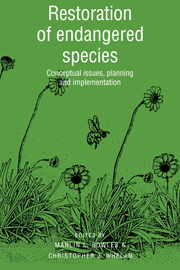Book contents
- Frontmatter
- Contents
- List of contributors
- Foreword
- Acknowledgments
- I Conceptual issues in restoration ecology
- II Restoration planning
- III Implemented restorations
- 10 The swift fox reintroduction program in Canada from 1983 to 1992
- 11 Restoration of the endangered black-footed ferret: a twenty-year overview
- 12 Development and implementation of a recovery program for the federally threatened Lakeside daisy (Hymenoxys acaulis var. glabra)
- 13 Demographic monitoring and the recovery of endangered plant populations
- IV Synthesis and future directions: biology, politics and reality
- Taxonomic Index
- Subject Index
12 - Development and implementation of a recovery program for the federally threatened Lakeside daisy (Hymenoxys acaulis var. glabra)
Published online by Cambridge University Press: 27 January 2010
- Frontmatter
- Contents
- List of contributors
- Foreword
- Acknowledgments
- I Conceptual issues in restoration ecology
- II Restoration planning
- III Implemented restorations
- 10 The swift fox reintroduction program in Canada from 1983 to 1992
- 11 Restoration of the endangered black-footed ferret: a twenty-year overview
- 12 Development and implementation of a recovery program for the federally threatened Lakeside daisy (Hymenoxys acaulis var. glabra)
- 13 Demographic monitoring and the recovery of endangered plant populations
- IV Synthesis and future directions: biology, politics and reality
- Taxonomic Index
- Subject Index
Summary
Introduction
The successful reintroduction of rare plants to the wild will depend upon knowledge of a species' life history and habitat requirements, the consideration of key genetic, demographic and ecological traits that affect vulnerability to stochastic extinction processes (Lande 1988, Menges 1991), and the identification of suitable restoration sites. Unfortunately for many rare plants, much of this information is lacking when recovery plans are written. As a result, the plans are often standardized, and the recommended research and management actions are too broad or are unrelated to immediate population survival (Cook & Dixon 1986).
Here I present a comprehensive approach to developing and implementing an Illinois recovery program for a federal threatened Great Lakes endemic, Hymenoxys acaulis var. glabra (Asteraceae), commonly known as the Lakeside daisy. After first providing distribution and life history information, I review the relevant aspects of breeding system studies and plant community and population structure data collected from naturally occurring populations. Second, I describe how these results were used in recovery strategies, specifically in planning the genetic composition and size of restored populations, the transplant design, and in the selection of suitable recovery sites. Finally, I describe the restoration process and provide preliminary results of the Lakeside daisy recovery program.
The Lakeside daisy
Distribution and status
Hymenoxys acaulis is distributed from western Canada southward to California, east through the western Great Plains and southeast into Texas (Harrington 1964).
- Type
- Chapter
- Information
- Restoration of Endangered SpeciesConceptual Issues, Planning and Implementation, pp. 298 - 321Publisher: Cambridge University PressPrint publication year: 1994
- 14
- Cited by



